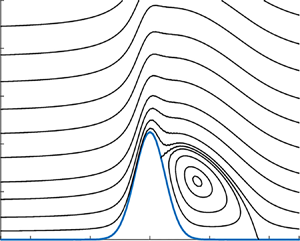Article contents
On boundary-layer receptivity to entropy waves
Published online by Cambridge University Press: 25 October 2021
Abstract

In this paper, we consider the generation of the Tollmien–Schlichting waves in the boundary layer on the surface of a wing exposed to entropy waves. It is well known that the free-stream turbulence is composed of two perturbation modes: the vorticity waves and the entropy waves. The receptivity of the boundary layer to the vorticity waves has been studied extensively by various authors. The entropy waves have not attracted such attention. We show that, in high speed subsonic flows, the entropy waves are as important for the receptivity as the vorticity waves. Methodologically, our work relies on the asymptotic analysis of the Navier–Stokes equations at large values of the Reynolds number, which results in the formulation of a suitably modified triple-deck theory. The entropy waves produce oscillations of the gas temperature and density, but the velocity and the pressure remain unperturbed to the leading order. This precludes the entropy waves from penetrating the boundary layer, as happens, for example, with the acoustic waves. Our analysis reveals that the entropy waves decay rapidly in the transition layer that forms near the outer edge of the boundary layer. We find that an entropy wave alone cannot generate the Tollmien–Schlichting waves. However, when the boundary layer encounters a wall roughness, the flow near the roughness appears to be perturbed not only inside the boundary layer but also in the inviscid region outside the boundary layer. The latter comes into the interaction with the density perturbations in the entropy wave. As a result, a localised ‘forcing’ is created that produces the Tollmien–Schlichting waves. In this paper we present the results of a linear and nonlinear receptivity analysis. We find that the nonlinearity enhances the receptivity significantly, especially when a local separation region forms on the roughness.
JFM classification
Information
- Type
- JFM Papers
- Information
- Copyright
- © The Author(s), 2021. Published by Cambridge University Press
References
REFERENCES
- 6
- Cited by


